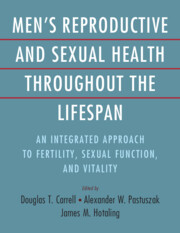 Men's Reproductive and Sexual Health Throughout the Lifespan
Men's Reproductive and Sexual Health Throughout the Lifespan Book contents
- Men’s Reproductive and Sexual Health throughout the Lifespan
- Men’s Reproductive and Sexual Health throughout the Lifespan
- Copyright page
- Contents
- Contributors
- Preface
- Section 1 An Introduction to Men’s Health Care
- Section 2 The Biology of Male Reproduction and Infertility
- Section 3 Clinical Evaluation and Treatment of Male Infertility
- Section 4 Laboratory Evaluation and Treatment of Male Infertility
- Section 5 Medical and Surgical Management of Issues of Male Health
- Chapter 32 Hypogonadism in the Male
- Chapter 33 Selective Androgen Receptor Modulators in the Treatment of Hypogonadism and Men’s Health
- Chapter 34 Male Fertility and Testosterone Therapy
- Chapter 35 Sleep and Men’s Health
- Chapter 36 Molecular Biology and Physiology of Erectile Function and Dysfunction
- Chapter 37 Evaluation of the Male with Erectile Dysfunction
- Chapter 38 Lifestyle Modifications for Erectile Dysfunction
- Chapter 39 Medical and Surgical Management of Erectile Dysfunction
- Chapter 40 Surgical Management of Peyronie’s Disease
- Chapter 41 Medical Management of Benign Prostatic Hyperplasia
- Chapter 42 Evidence-Based Management of Chronic Orchialgia and Chronic Prostatitis/Chronic Pelvic Pain Syndrome
- Index
- References
Chapter 41 - Medical Management of Benign Prostatic Hyperplasia
from Section 5 - Medical and Surgical Management of Issues of Male Health
Published online by Cambridge University Press: 06 December 2023
- Men’s Reproductive and Sexual Health throughout the Lifespan
- Men’s Reproductive and Sexual Health throughout the Lifespan
- Copyright page
- Contents
- Contributors
- Preface
- Section 1 An Introduction to Men’s Health Care
- Section 2 The Biology of Male Reproduction and Infertility
- Section 3 Clinical Evaluation and Treatment of Male Infertility
- Section 4 Laboratory Evaluation and Treatment of Male Infertility
- Section 5 Medical and Surgical Management of Issues of Male Health
- Chapter 32 Hypogonadism in the Male
- Chapter 33 Selective Androgen Receptor Modulators in the Treatment of Hypogonadism and Men’s Health
- Chapter 34 Male Fertility and Testosterone Therapy
- Chapter 35 Sleep and Men’s Health
- Chapter 36 Molecular Biology and Physiology of Erectile Function and Dysfunction
- Chapter 37 Evaluation of the Male with Erectile Dysfunction
- Chapter 38 Lifestyle Modifications for Erectile Dysfunction
- Chapter 39 Medical and Surgical Management of Erectile Dysfunction
- Chapter 40 Surgical Management of Peyronie’s Disease
- Chapter 41 Medical Management of Benign Prostatic Hyperplasia
- Chapter 42 Evidence-Based Management of Chronic Orchialgia and Chronic Prostatitis/Chronic Pelvic Pain Syndrome
- Index
- References
Summary
Benign prostatic hyperplasia is the most common benign neoplasm in males in the United States. It is characterized by lower urinary tract symptoms: weak stream, urinary frequency, urgency, incomplete emptying, hesitancy, nocturia, and acute urinary retention. These symptoms are generally slowly progressive and left untreated can cause irreversible bladder damage. Diagnosis is mostly clinical and based on symptomatology; however, the use of some objective tests can be helpful. Treatment options include lifestyle modification as well as a variety of different pharmacologic agents.
Keywords
- Type
- Chapter
- Information
- Men's Reproductive and Sexual Health Throughout the LifespanAn Integrated Approach to Fertility, Sexual Function, and Vitality, pp. 323 - 328Publisher: Cambridge University PressPrint publication year: 2023
